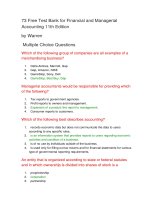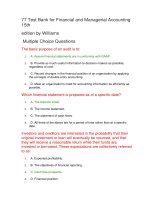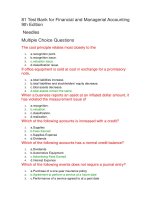56 free test bank for fundamental financial and managerial accounting concepts 1st edition by edmonds multple choice questions
Bạn đang xem bản rút gọn của tài liệu. Xem và tải ngay bản đầy đủ của tài liệu tại đây (34.74 KB, 10 trang )
56 Free Test Bank for Fundamental Financial and
Managerial Accounting Concepts 1st Edition By
Edmonds Multple Choice Questions - Page 1
Which financial statement is sometimes called the statement of
financial position?
1.
2.
3.
4.
A. income statement
B. statement of changes in equity
C. balance sheet
D. statement of cash flows
Conversion agents acquire financial resources from
1.
2.
3.
4.
A. consumers.
B. investors.
C. creditors.
D. both B and C.
The broad categories of information reported on a business's
financial statements are referred to as
1.
2.
3.
4.
A. accounts.
B. elements of the financial statements.
C. components.
D. assets.
Which of the following groups has primary responsibility for
establishing generally accepted accounting principles for
businesses in the United States?
1.
2.
3.
4.
A. the US Congress
B. the Securities and Exchange Commission
C. the Financial Accounting Standards Board
D. the Internal Revenue Service
A stockholder in a corporation would use ___ to learn about the
company
1.
2.
3.
4.
A. financial accounting information
B. managerial accounting information
C. not-for-profit accounting information
D. both A and C
Shale Corporation acquired cash by issuing common stock for
$50,000. As a result of this event,
1.
2.
A. retained earnings increased.
B. assets increased.
3.
4.
C. liabilities increased.
D. both B and C.
An investor provides resources to a business in exchange for
1.
2.
3.
4.
A. physical resources.
B. priority of claims in event of liquidation.
C. an ownership interest in the business.
D. a promise that the resources will be repaid at a given date.
Which is the only financial statement for which FASB required a
specific title?
1.
2.
3.
4.
A. balance sheet
B. income statement
C. statement of cash flows
D. statement of changes in stockholders' equity
Open markets are created by and made up of
1.
2.
3.
4.
A. resource owners.
B. conversion agents.
C. consumers.
D. all of the above.
Which financial statement reports the results of a business's
operations?
1.
2.
3.
4.
A. income statement
B. statement of changes in equity
C. balance sheet
D. statement of cash flows
During 2007, Cruz Company earned $5,000 in cash revenue,
incurred $3,700 in cash expenses, and paid $500 in cash dividends
to its owners. Based on this information,
1.
2.
3.
4.
A. retained earnings increased by $800 during the year.
B. net income was $800 for 2007.
C. the net cash flow from operating activities was $800 for the year.
D. total assets increased by $1,300 during 2007.
The balance sheet for Moore Company shows total assets of
$4,000, liabilities of $1,500, and retained earnings of $800. Based
on this information, the amount of common stock must be
1.
2.
3.
4.
A. $700.
B. $5,500.
C. $4,700.
D. $1,700.
In a market, _____ are conversion agents.
1.
2.
3.
4.
A. businesses
B. consumers
C. financial institutions
D. governments
A business's resources are called
1.
2.
3.
4.
A. assets.
B. liabilities.
C. equity.
D. revenue.
Liabilities are
1.
2.
3.
4.
A. claims of creditors.
B. the owner's interest in the company.
C. claims of investors.
D. both A and B.
As of December 31, 2007, Bueno Company had $2,000 in liabilities,
$8,000 in common stock, and $2,500 in retained earnings. The total
amount of assets on that date is
1.
2.
3.
4.
A. $10,000.
B. $12,500.
C. $3,500.
D. $7,500.
A business's equity comes from
1.
2.
3.
4.
A. its creditors.
B. investments by owners.
C. amounts earned by the business.
D. both B and C
A creditor
1.
A. provides financial resources to a business in exchange for an ownership
interest.
2. B. provides labor resources to a business.
3. C. provides financial resources to a business on a lending basis.
4. D. is a resource user.
The claims side of the accounting equation
1.
2.
3.
4.
A. lists the resources that a business owns or controls.
B. is a listing of the sources of the business's assets.
C. must balance out to zero.
D. indicates the amount of profit that a business has earned.
The accounting equation may be written,
1.
2.
3.
4.
A. Revenues – Expenses = Net Income.
B. Assets = Liabilities.
C. Liabilities = Equity.
D. Assets = Claims.
In event of liquidation of a business,
1.
2.
3.
4.
A. creditors have priority claim on the business's assets.
B. investors have priority claim on the business's assets.
C. resource users have priority claim on the business's assets.
D. stakeholders are assured of receiving the resources they had provided to
the business.
Resources that a business uses to produce earnings are called
1.
2.
3.
4.
A. assets.
B. equity.
C. revenues.
D. liabilities.
Generally accepted accounting principles (GAAP) are measurement
rules for
1.
2.
3.
4.
A. managerial accounting.
B. tax accounting.
C. financial accounting.
D. measuring the cost of goods or services provided to customers.
In a market, _____ are resource users.
1.
2.
3.
4.
A. businesses
B. consumers
C. financial institutions
D. governments
Accounting information focused on the needs of external users is
1.
2.
3.
4.
A. financial accounting.
B. managerial accounting.
C. claims accounting.
D. not-for-profit accounting.
56 Free Test Bank for Fundamental Financial and
Managerial Accounting Concepts 1st Edition By
Edmonds Multple Choice Questions - Page 2
Chen Company paid $3,000 cash for utility expenses. What kind of
transaction is this?
1.
2.
3.
4.
A. asset source transaction
B. asset use transaction
C. asset exchange transaction
D. claims source transaction
An asset source transaction
1.
2.
3.
4.
A. increases one asset and decreases another.
B. increases an asset and increases a liability or equity.
C. increases an asset and decreases a liability or equity.
D. decreases an asset and increases a liability.
Paradox Company earned $45,000 of cash revenue. What kind of
transaction is this?
1.
2.
3.
4.
A. asset source transaction
B. asset use transaction
C. asset exchange transaction
D. claims source transaction
Which of the following financial statements provides information at a
specific point in time?
1.
2.
3.
4.
A. income statement
B. statement of changes in stockholders' equity
C. statement of cash flows
D. balance sheet
Which of the following items would be an example of revenue?
1.
2.
3.
4.
A. cash investments made by owners
B. cash received from a bank loan
C. cash received from customers for services provided
D. all of the above
Hamilton Company began operations in 2007. During the year, the
following cash transactions occurred: (1.) issued stock for $40,000;
(2.) borrowed $20,000 from bank; (3.) provided services to
customers for $53,000 cash; (4.) paid back $8,000 of the loan from
the bank; (5.) paid rent expense, $9,000; (6.) purchased equipment
costing $15,000; (7.) paid operating expenses, $25,000; (8.) paid
$4,000 dividend to stockholders. What was the cash flow from
financing activities?
1.
2.
3.
4.
A. an inflow of $60,000
B. an inflow of $52,000
C. an inflow of $36,000
D. an inflow of $48,000
Accounting information is said to be reliable if
1.
2.
A. it is based on recent information.
B. it was prepared by someone with good credentials in accounting, such as a
CPA certificate.
3. C. it can be independently verified.
4. D. it complies with rules and standards of the Internal Revenue Service.
Hamilton Company began operations in 2007. During the year, the
following cash transactions occurred: (1.) issued stock for $40,000;
(2.) borrowed $20,000 from bank; (3.) provided services to
customers for $53,000 cash; (4.) paid back $8,000 of the loan from
the bank; (5.) paid rent expense, $9,000; (6.) purchased equipment
costing $15,000; (7.) paid operating expenses, $25,000; (8.) paid
$4,000 dividend to stockholders. What amount of cash did Hamilton
have at the end of 2007?
1.
2.
3.
4.
A. $48,000
B. $56,000
C. $52,000
D. $67,000
Dividends paid by a company are shown on the
1.
2.
3.
4.
A. income statement.
B. balance sheet.
C. statement of changes in stockholders' equity.
D. all of the above.
Raven Company spent cash to purchase equipment. As a result of
this event,
1.
2.
3.
4.
A. total liabilities increased.
B. total assets increased.
C. net income increased.
D. total assets were unchanged.
The term "articulation"
1.
2.
A. indicates that there are interrelationships among the financial statements.
B. requires that asset decreases (expenses) be matched with asset increases
(revenues).
3. C. refers to the requirement that separate financial statements be prepared for
separate entities.
4. D. means that a business's financial statements are prepared for specified
periods of time.
Which of the following items would appear in the financing activities
section of a statement of cash flows?
1.
A. received cash revenue from customers
2.
3.
4.
B. paid cash for dividends
C. purchased equipment for cash
D. paid cash for utility bill
Dayton Company provided services to a customer for $700 cash.
As a result of this event,
1.
2.
3.
4.
A. total assets decreased.
B. total liabilities increased.
C. retained earnings increased.
D. cash flows from financing activities increased.
Grace Company purchased equipment for $45,000. As a result of
this event, Grace had a
1.
2.
3.
4.
A. $45,000 cash outflow from financing activities.
B. $45,000 cash inflow from financing activities.
C. $45,000 cash outflow from investing activities.
D. $45,000 cash outflow from operating activities.
Beatrice Company earned $4,000 in cash revenues, paid cash
expenses of $3,450, and paid a cash dividend of $300 to its
owners. It engaged in no other transactions during the period.
Which of the following statements is true?
1.
2.
A. The cash flow from financing activities was $0.
B. The net cash flow from operating activities was an inflow or increase of
$550.
3. C. The net cash flow from operating activities was an inflow or increase of
$250.
4. D. The cash flow from investing activities was an increase of $250.
Expenses are shown on the
1.
2.
3.
4.
A. income statement.
B. statement of changes in stockholders' equity.
C. balance sheet.
D. all of the above.
If a company receives cash for providing services to customers, that
transaction is
1.
2.
3.
4.
A. an asset source transaction.
B. an asset use transaction.
C. an asset exchange transaction.
D. either A or C
In 1998, Parker Corporation purchased land for $85,000. In 2007,
Parker Company had the land appraised, and its value was
estimated to be $190,000. Also during 2007, another company
offered Parker $145,000 for the parcel of land. When the balance
sheet is prepared at the end of 2007, at what dollar amount should
the land be reported?
1.
2.
3.
4.
A. $190,000
B. $85,000
C. $145,000
D. none of the above
An asset decrease resulting from consumption of resources to earn
revenue is
1.
2.
3.
4.
A. a net loss.
B. a liability.
C. an expense.
D. an asset source transaction.
Which of the following items would appear on a balance sheet?
1.
2.
3.
4.
A. Notes Payable
B. Dividends
C. Expenses
D. Revenues
Hamilton Company began operations in 2007. During the year, the
following cash transactions occurred: (1.) issued stock for $40,000;
(2.) borrowed $20,000 from bank; (3.) provided services to
customers for $53,000 cash; (4.) paid back $8,000 of the loan from
the bank; (5.) paid rent expense, $9,000; (6.) purchased equipment
costing $15,000; (7.) paid operating expenses, $25,000; (8.) paid
$4,000 dividend to stockholders. What was the cash flow from
investing activities?
1.
2.
3.
4.
A. an outflow of $15,000
B. an outflow of $19,000
C. an inflow of $65,000
D. an outflow of $23,000
Hamilton Company began operations in 2007. During the year, the
following cash transactions occurred: (1.) issued stock for $40,000;
(2.) borrowed $20,000 from bank; (3.) provided services to
customers for $53,000 cash; (4.) paid back $8,000 of the loan from
the bank; (5.) paid rent expense, $9,000; (6.) purchased equipment
costing $15,000; (7.) paid operating expenses, $25,000; (8.) paid
$4,000 dividend to stockholders. What was the cash flow from
operating activities?
1.
2.
3.
4.
A. an inflow of $4,000
B. an inflow of $19,000
C. an inflow of $11,000
D. an inflow of $15,000
An asset use transaction
1.
2.
3.
4.
A. increases one asset and decreases another.
B. decreases an asset and decreases a liability or equity.
C. increases an asset and decreases a liability or equity.
D. increases an asset and increases a liability or equity.
Which of the following transactions is an asset source transaction?
1.
2.
3.
4.
A. acquired office supplies by signing a short-term note payable
B. paid cash to purchase land
C. paid cash for operating expenses
D. paid cash dividends to owners
Liabilities are shown on the
1.
2.
3.
4.
A. income statement.
B. statement of changes in stockholders' equity.
C. statement of cash flows.
D. balance sheet.
The amount of land owned by a business appears on which
financial statement?
1.
2.
3.
4.
A. income statement
B. statement of changes in stockholders' equity
C. statement of cash flows
D. balance sheet
Most assets must be reported on the balance sheet at
1.
2.
3.
4.
A. their current replacement cost.
B. fair market value.
C. an amount estimated by the company's management.
D. historical cost.
A company's retained earnings at the beginning and ending of the
accounting period were $48,000 and $55,000, respectively. If the
company had revenues of $61,000 and expenses of $52,000, the
amount of cash dividends paid must have been
1.
2.
3.
A. $2,000.
B. $9,000.
C. $3,000.D. $4,000.
Which of the following transactions is an asset use transaction?
1.
2.
3.
4.
A. payment of cash dividends to owners
B. paying cash to acquire furniture
C. acquiring cash by issuing stock to owners
D. providing services to customers for cash
If a company's expenses are greater than its revenues for the year,
1.
2.
3.
4.
A. its assets increased during the period.
B. the company incurred a net loss during the period.
C. the company's liabilities must have increased.
D. the company's stockholders' equity must have decreased during the
period.
Which of the following is NOT an asset use transaction?
1.
2.
3.
4.
A. paying cash dividends
B. purchasing land
C. paying off the principal on a loan
D. paying salaries to employees









